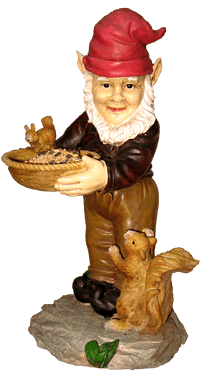Plants That Attract and Feed Song Birds
(Check cultural requirements for local suitability.)
|
(A) ANNUAL (P) PERENNIAL (D) DECIDUOUS (E) EVERGREEN
|
TREES for shelter and protection
Larger trees planted at the borders of your property provide a safe starting point for visiting birds. These plants are important for escape from predators, winter shelter, and summer nesting sites. They may also provide food in the form of seeds, berries, and sap.
|
Flowering Dogwood (D)
Cornus florida |
American Holly (E)
Ilex opaca |
Red Cedar (E)
Juniperus virginiana |
Red Mulberry (D)
Morus rubra |
Colorado blue spruce (E)
Picea pungens |
Douglas fir (E)
Pseudotsuga menziesii |
White cedar (E)
Chamaecyparis thyoides |
Bald cypress (D)
Taxodium distichum |
White fire (E)
Abies concolor |
Ponderosa pine (E)
Pinus ponderosa |
Rocky Mountain juniper
J. scopulorum |
Austrian pine (E)
Pinus nigra |
California juniper (E)
J. californica |
Alternate leaf Dogwood (D)
Cornus alternifolia |
American Mountain Ash (D)
Sorbus americana |
Red-osier
Dogwood(D)
Cornus stolonifera |
Silky Dogwood (D)
Cornus amomum |
Gray Dogwood (D)
Cornus racemosa |
Hackberry (D)
Celtis occidentalis |
Sassafras (D)
Sassafras albidium |
Oak (D)
Quercus sp. |
Hazelnut (D)
Corylus avellana |
Chestnut (D)
Castanea sp. |
Black walnut (D)
Junglens nigra |
ANNUALS AND PERENNIALS for fruit and seed
Many flowering plants produce large quantities of seed each year. This is a very important food source for many sparrows, finches and other songbirds. At the end of the blooming season, don't cut the spent flowers off, but allow them to dry and hang in place. |
Penstemon(P)
Penstemon spectabilis |
Sunflower (A)
Helianthus annuus |
Tickseed (P)
Coreopsis sp. |
Bee Balm (P)
Monarda |
Floss flower (A)
Ageratum houstonianum |
Aster (A)(P)
Aster sp. |
Goldenrod (P)
Solidago |
Cosmos (A)(P)
Cosmos sp. |
Bachelor's Button (A)
Centaurea cyanus |
Larkspur (A)
Consolida ambigua |
Spider flower (A)
Cleome spinosa |
Snapdragon(A)
Antirrhinum majus |
Purple Coneflower (P)
Echinacea purpurea |
Four O'Clocks (A)(P)
Mirabilis jalapa |
Cockscomb (A)
Celosia sp. |
SHRUBS AND VINES
Plant shrubs in clumps or hedgerows so birds can observe the yard while hidden from the view of cats and other predators. By the same token, place your bird feeders and bird baths away from places where cats may lay in waiting for an unsuspecting bird. Almost any fruiting plant provides food for the birds, but plants like raspberries tend to be picked clean, long before the summer is over. The following shrubs and vines tend to hold their fruits and seeds through the fall and into the winter months.
|
Salal(E)
Gaultheria shallon |
Oregon Grape(E)
Mahonia aquifolium |
Beautyberry(D)
Callicarpa bodinieri |
Silverberry (D)
Eleagnus commutata |
Bayberry (D)
Myrica pensylvanica |
Chokecherry (D)
Prunus virginiana |
Virginia Creeper (D)
Parthenocissus quinquefolia |
Firethorn (E)
Pyracantha coccinea |
Flowering Currant (D)
Ribes sanguineum |
Elderberry (D)
Sambucus sp. |
Blueberry (D)
Vaccinium corymbosum |
Huckleberry (D)(E)
Vaccinium ovatum |
Cranberry bush (D)
Viburnum trilobum |
Blackberry (D)
Blackberry |
Cotoneaster (D)
Cotoneaster |
Crabapple (D)
Malus sp. |
Japanese Yew (E)
Taxus cuspidata |
Sumac (D)
Rhus sp. |
Manzanita (E)
Arctostaphlos sp. |
Creeping juniper (E)
Juniperus horizontalis |
Common juniper (E)
Juniperus communis |
